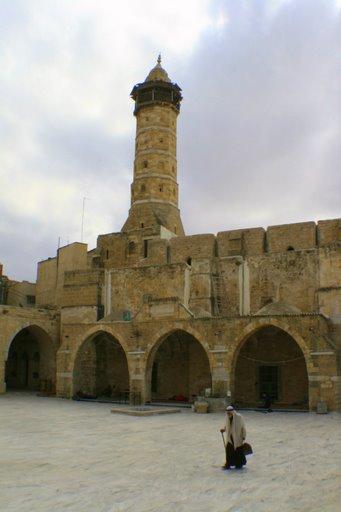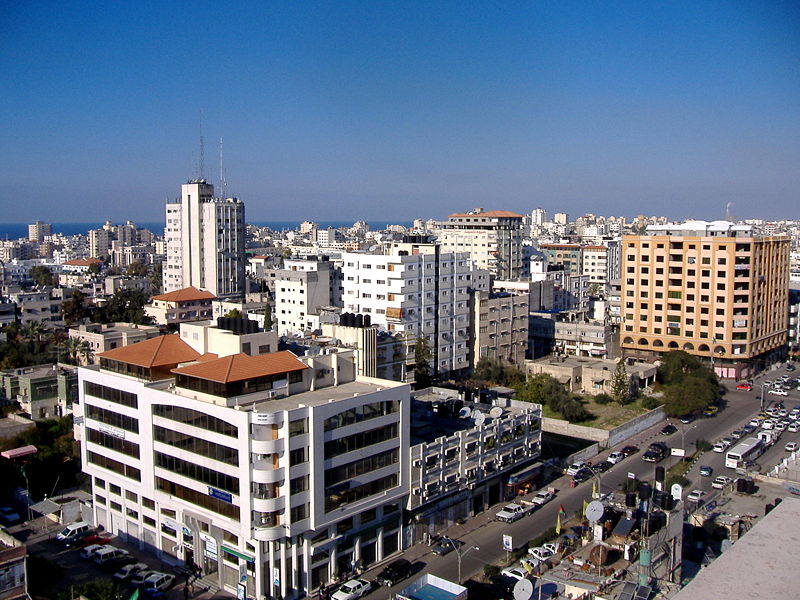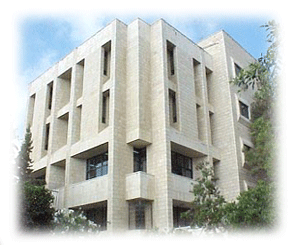|

Painting of Gaza by
David
Roberts, 1839 |
Early
History of Gaza
The
Canaanites are believed to have given Gaza its name,
which means strength. The Egyptians called it “Gazzat”.
The Persians have called it “treasure”, and the Arabs
often refer to it as Gazzat hashim, in honor of Hashim
the Prophet Moh’d’s great grandfather, who is buried
here.
|

Gaza Sea at sunset |
A
joint Palestinian-French dig began in 1998-1999 in Wadi
Gaza unearthing a wall city Tel al-Sakn dated to 3200
BCE. The city was abandoned around 2000 BCE when its
inhabitants moved to Gaza’s ancient capital Tell el-Ajjoul,
the city that was a Canaanite city under Egyptian
influence. The inhabitants were
fishermen, hunters, cultivators and were knowledgeable
in bronze and iron production.
|

Mosaics in Gaza |
The
Philistines inherited the coast from the Canaanites, and
they brought decorative and elaborate art, mercantile
skills, new burial customs and advanced knowledge of
metalworking and warfare. Despite the opposition to
their presence in Canaan they stayed and integrated.
Most scholars have studied the Philistines and their
accomplishments.
Christianity: On the eve of Jesus’ birth in Bethlehem,
Gaza was a center for pagan deities and Hellenistic
culture and remained until the 4th century. Gazans had
their household gods, street corner idols and special
rituals associated with birth, harvest, marriage, rain
and death. The upper classes and intellectuals paid
homage to the Greek deities. Christianity continued to
be practiced underground until the rule of Constantine.
A 400-year battle between the pagan gods and forces of
Christianity was fierce and bloody. Hilarion, a leading
figure of Christianity was the Gazan founder of monastic
life in Palestine. Near his birthplace of Tabatha known
as Um al-Tuut (Nuseirat), he built a monastery. The
Christian era began for Gazans in 402 when the Byzantine
Emperor Acadius instructed his troops to burn the
holiest shrine in Gaza, the temple of Marna. Many local
people fled , and many buried or hid their own deities
to save them from the Christian authorities. In the
place of the temple, a church named Eudochia was built
and close by stands the church of St. Porphyry and a
Christian cemetery still stands to the church. The
church belongs to the small Christian community of the
Greek Orthodox.
|

Saint Porphyrius Church |
|

Muslims studying the Qur'an
with Gaza in the background,
painting by Harry Fenn |
In the early Christian era (484-550) Gaza was home to some
of the most important thinkers and scholars in the
region. At about this time, pilgrims began to visit the
Holy Land. Churches added hostels, and Gazans made
souvenirs of dried earth with clay stamps and
inscriptions. Gaza was second to Jerusalem in
size by 527. By this time the prophet Muhammad was born
(c.570 CE). When Islam came in 637, Gazans were
among the first to pledge their allegiance to the new
religion. Islam came to them in Arabic, a Semitic
language akin to their own Aramaic. Merchants from the
Arabian Peninsula, Africa, and Egypt had traded in and
traveled to Gaza for centuries, using it as a base for
their business ventures in the Levant and as far afield
as Iraq, Persia and India. Among these merchants was an
Arabian named Hashim Ibn Abd Manaf who lived in the
middle of the 6th century. Hashim died in
Gaza before his great-grandson, Muhammad, became the
Prophet of Islam. Out of respect for the Prophet
Muhammad, Hashim’s grave became a shrine, venerated by
visitors to this day.
|

The Great Mosque
of Gaza is the
oldest
mosque in the city |
Many of
the Arabians who would become the Prophet Muhammed’s
companions had visited Gaza as traders before the birth
of Islam. Omar ibn al-Khattab, later credited with the
Islamization of Palestine , was such friend. Many
mosques and public buildings are still named in his
honor. In 1614 before the advent of Islam, the wars
between Byzantium and the Persians led to the
destruction of the church of Eudochia. Since it was seen
as the center for religious veneration, converted Gazans
pushed to have a mosque built at the site. Remains of
the church are still visible in parts of the mosque. By
the early 10th century, an Islamic/Arab
character was in place. The Abbasids built watchtowers
along the coast at Maioumas-Gaza, Askalan, Isdud, Ybna
and Jaffa.
“Gaza
remains standing today, even if its hands are tied. Its
horizon is fenced off. Yet the Gaza Strip harmoniously
continues the long Arab coastline south along the
Mediterranean. In olden times, it was called Syrian, but
its scenery already has an Egyptian air. It also went by
the name of “Arab Gaza”
because it was the natural terminus of the Arabian
Peninsula on the Mediterranean.”
Jean-Baptiste Humbert in Mediterranean Gaza-History and
Archaeology in Palestine.
|

Gaza |
Sources:
Palestine: a guide by Mariam Shahin.
©2005.
Palestine and the Palestinians: guidebook by Alternative
Tourism Group, ©2005.
Photos taken from:
http://en.wikipedia.org/?title=Gaza,
Palestine: The Holy Land, Ministry of Tourism, n.d. |








